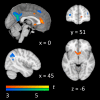Longitudinal change in the neural bases of adolescent social self-evaluations: effects of age and pubertal development
- PMID: 23616547
- PMCID: PMC3809090
- DOI: 10.1523/JNEUROSCI.4074-12.2013
Longitudinal change in the neural bases of adolescent social self-evaluations: effects of age and pubertal development
Abstract
Self-evaluations undergo significant transformation during early adolescence, developing in parallel with the heightened complexity of teenagers' social worlds. Intuitive theories of adolescent development, based in part on animal work, suggest that puberty is associated with neural-level changes that facilitate a "social reorientation" (Nelson et al., 2005). However, direct tests of this hypothesis using neuroimaging are limited in humans. This longitudinal fMRI study examined neurodevelopmental trajectories associated with puberty, self-evaluations, and the presumed social reorientation during the transition from childhood to adolescence. Participants (N = 27, mean age = 10.1 and 13.1 years at time points one and two, respectively) engaged in trait evaluations of two targets (the self and a familiar fictional other), across two domains of competence (social and academic). Responses in ventromedial PFC increased with both age and pubertal development during self-evaluations in the social domain, but not in the academic domain. These results suggest that changes in social self-evaluations are intimately connected with biology, not just peer contexts, and provide important empirical support for the relationship between neurodevelopment, puberty, and social functioning.
Figures


Comment in
-
Neural mechanisms of social reorientation across adolescence.J Neurosci. 2013 Aug 21;33(34):13581-2. doi: 10.1523/JNEUROSCI.2667-13.2013. J Neurosci. 2013. PMID: 23966681 Free PMC article. No abstract available.
References
-
- Bramen JE, Hranilovich JA, Dahl RE, Forbes EE, Chen J, Toga AW, Dinov ID, Worthman CM, Sowell ER. Puberty influences medial temporal lobe and cortical gray matter maturation differently in boys than girls matched for sexual maturity. Cereb Cortex. 2011;21:636–646. doi: 10.1093/cercor/bhq137. - DOI - PMC - PubMed
Publication types
MeSH terms
Grants and funding
LinkOut - more resources
Full Text Sources
Other Literature Sources
Medical
Miscellaneous
